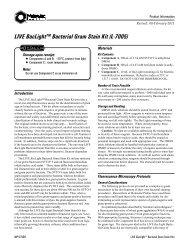Vertical Vegetation Structure Below Ground: Scaling from Root
Vertical Vegetation Structure Below Ground: Scaling from Root
Vertical Vegetation Structure Below Ground: Scaling from Root
Create successful ePaper yourself
Turn your PDF publications into a flip-book with our unique Google optimized e-Paper software.
342 EcologyBecause vegetation structure is largely determined by the spatial distributionof resource-acquiring organs,there ought to be predictable relationshipsbetween vertical vegetation structure and the vertical distribution ofplant resources in space and time. Indeed,the structure of plant canopiesis strongly related to the temporal and spatial distribution of light intensity,even though physical factors that act as stressors also play a major role instructuring vegetation above ground (Russell et al. 1989; Ehleringer andField 1993). Understanding such relationships has enabled ecologists to useinformation about environmental conditions to successfully predict thespatial structure of plant canopies at scales ranging <strong>from</strong> individual plantsto whole communities (Horn 1971; Botkin et al. 1972; Schieving and Poorter1999; Anten and Hirose 2001) and even to global vegetation (Haxeltine andPrentice 1996; Bonan et al. 2003; Sitch et al. 2003).Recent innovations in the methodology of root research (Smit et al. 2000)have enabled much progress toward understanding relationships betweenroots,soil resources,and other physical and biotic soil factors,a factattested to by two recent edited volumes on root biology and ecology(Waisel et al. 2002; de Kroon and Visser 2003). However,until very recentlythere have been relatively few attempts to synthesize and integrate suchinformation in order to develop predictive models of spatial root distributions.Such models are now being developed and are discussed at the endof this chapter.This chapter explores the current state of information about quantitativerelationships between root growth and physical factors,such as soil characteristicsand water availability,and assesses the usefulness of this informationfor developing predictive models of vertical vegetation structurebelow ground at scales ranging <strong>from</strong> root systems to global vegetation. Suchmodels would greatly help us to quantify interactions between climate,soil,and plants,to better predict patterns of water and nutrient uptake by plants,and thus to better predict changes in the structure and function of vegetationabove and below ground in response to global change. In the following,we will discuss the factors that influence the spatial distribution of roots,beginning at the scale of individual roots and parts of root systems,thenscale up to root systems of individual plants,to plant populations andcommunities,and finally to global vegetation. This is followed by a reviewof theoretical and empirical models that may be used to predict the verticalvegetation structure below ground and scale up <strong>from</strong> individual roots androot systems to the globe.
















